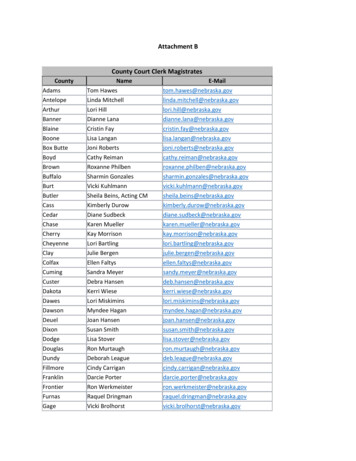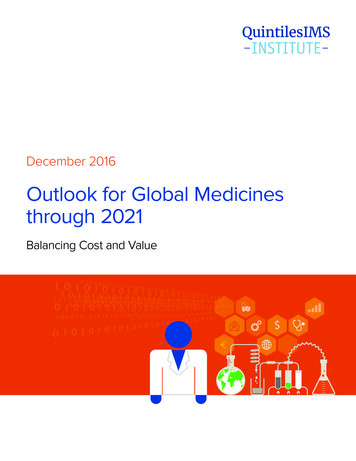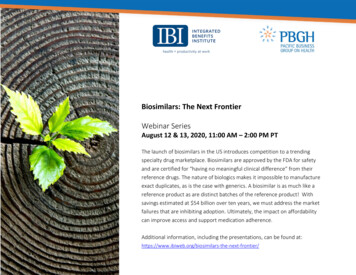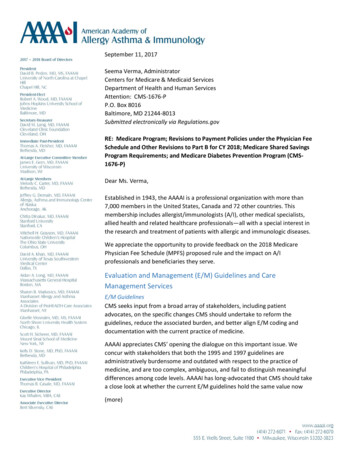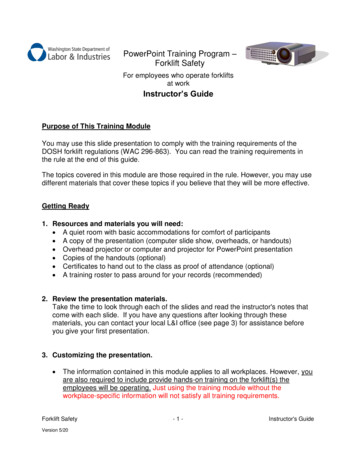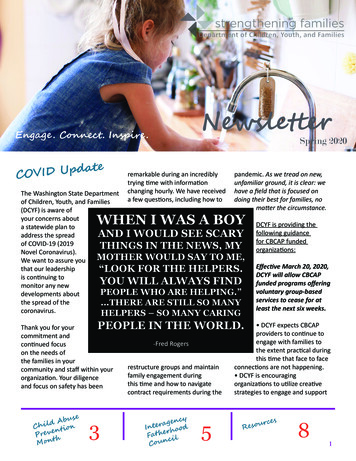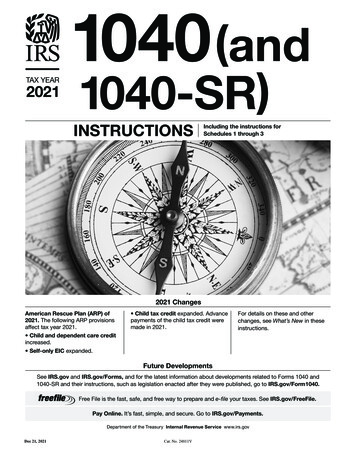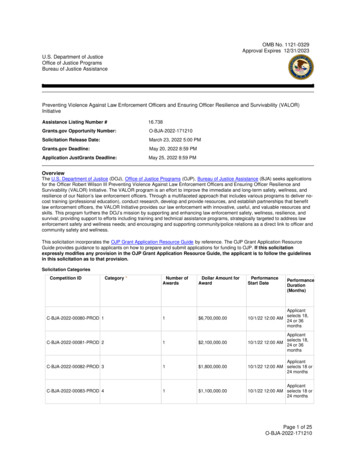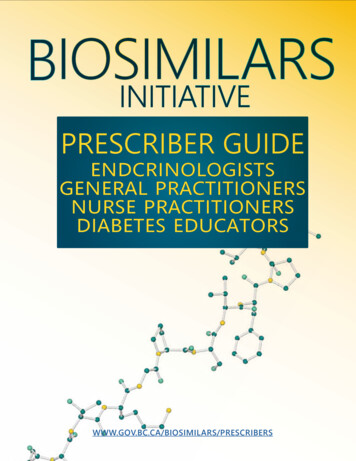
Transcription
BIOSIMILARSINITIATIVEPRESCRIBER GUIDEendcrinologistsgeneral practitionersnurse practitionersdiabetes educatorsWWW.GOV.BC.CA/BIOSIMILARS/PRESCRIBERS
BRITISH COLUMBIA PHARMACAREBIOSIMILARS INITIATIVEPRESCRIBER GUIDE: ENDOCRINOLOGISTS, GPS, NPS, &DIABETES EDUCATORSInIn ThisThis GuideGuideIntroduction.3What is changing?.4When do these changes take effect?.5Who will be affected?.5How can I identify which of my patients will be affected?.5Are Special Authority criteria changing?.5Will patients need new Special Authority approval?.6Why is coverage changing?.6What evidence supports biosimilar adoption and switch?.6What is the Biosimilar Patient Support Fee?.7What do I need to do to switch patients?.7What about patients who cannot switch to a biosimilar?.7How can I support patients with questions and concerns?.8What is the nocebo effect and how can I help prevent it?.9Will this be the only biosimilar switch?.10Where can I find more resources for my patients?.10What if I have questions or need more information?.11Biosimilar Basics: A Primer for Patient DiscussionsWhat is a biologic drug?.12What is a biosimilar drug?.12How is a biosimilar proven to be safe and effective?.13Are biosimilars interchangeable with their biologic originator?.13What are the benefits of biosimilars?.13What are the officials saying about biosimilars?.14Across Canada, biologic drugs are a major contributor to healthcare costs increasing at anunsustainable rate. In 2017, Canada spent over 1.1 billion on Remicade alone (more than onany other drug) and 274 million on Lantus (more than any other diabetes drug). With newdrugs frequently entering the market (including new biologics and innovative therapies), the costpressures for Canada’s drug plans will only continue to increase.One solution to this challenge is already available: biosimilar versions of originator biologicdrugs offer significant cost savings. In B.C., Basaglar offers a 25% reduction in cost compared toLantus, and others, such as infliximab biosimilars, represent as much as a 50% reduction in cost).Despite these price differences, biosimilars have not yet captured much market share in Canada.At the end of 2017, Basaglar (approved in Canada since September 2015) accounts for only2.6% of insulin glargine use, and infliximab biosimilars (approved in Canada since January 2014)account for only 4% of infliximab use.Biosimilar uptake has been limited by many factors, including misconceptions about the safetyand efficacy of biosimilars and reluctance to change the status quo.B.C.’s previous strategy to encourage biosimilar uptake by listing those brands preferentially fortreatment-naïve patients has been well-received; however, the impact of this strategy is limitedby the small proportion of new starts.With an ever-growing body of evidence and the support of stakeholders, PharmaCare is nowpositioned to enable the expansion of treatment options and the improvement of patient accessby introducing a Biosimilars Initiative.The Biosimilars Initiative changes coverage for specific biologic drugs. Patients and theirprescribers have a period of 6 months to discuss switching from an originator brand to abiosimilar brand. Coverage and Special Authority (SA) approval is provided for both originatorand biosimilar brands during the switch. Patients unable to switch or who have an adverseresponse to the biosimilar(s) can seek exceptional SA coverage for the originator.PharmaCare’s strategy to ensure a successful switch includes: Involving various practitioners in patient identification, education and supportProviding time to identify affected patients and guide them through the switch processEnsuring patient supports are in place for continuous careHaving options for those unable to switch or experience challenges with switchingIdentifying areas of concern and providing information for both patients and practitionersProviding call-in information sessions and responsive contacts for healthcare practitionersMonitoring drug utilization, patient outcomes, and stakeholder feedbackThe role of the prescriber in the switch process is paramount. A prescriber sets the tone ofthe switch discussion, serving as the primary and most trusted information source, facilitatescontinuity of care, and empowers the patient to expect and realize the best outcomes.In accordance with Health Canada recommendations, the decision to switch to a biosimilarshould be made by a well-informed patient and their prescriber. PharmaCare has created thisguide to provide information to support your discussions with affected patients.(National statistics referenced in the section above are found in the Patented Medicine Prices Review Board Meds Entry Watch 2017 report.)3
What is changing?When do these changes take effect?PharmaCare is changing coverage of certain biological drugs, including insulin glargine.Patients using Lantus who wish to maintain PharmaCare coverage must switch toBasaglar before November 26, 2019.Coverage for the original biologic (originator) drugs will be discontinued for affected patients, andcoverage will instead be provided for their biosimilars:PHASE 1: May 27 to November 25, 2019DrugOriginatoretanerceptBiosimilarsIndications AffectedBrenzys Ankylosing SpondylitisRheumatoid ArthritisErelzi Ankylosing SpondylitisPsoriatic ArthritisRheumatoid ArthritisInflectra Renflexis Ankylosing SpondylitisPlaque PsoriasisPsoriatic ArthritisRheumatoid ArthritisEnbrel infliximabRemicade insulin glargineLantus Basaglar Diabetes (Type 1 and 2)For affected patients with existing Special Authority (SA) approval for insulin glargine to maintain theircoverage, prescribers must write a new prescription, indicating the switch to a biosimilar option. Thepatient’s existing SA remains in effect until the next renewal date (if applicable).New SA requests and renewals for insulin glargine will be granted for Basaglar only.At this time, coverage of etanercept and infliximab is also changing. If your patients may be affectedby this change in addition to their insulin glargine, please encourage them to speak with theirrheumatologist or dermatologist.In Phase 2 of the Biosimilars Initiative, PharmaCare will change coverage for patients taking Remicadefor Crohn’s disease or ulcerative colitis. The switching of Remicade patients has been designed in twophases to allow for stakeholder engagement and ensure that switch support resources have capacity toaddress patient and prescriber needs.PHASE 2: Summer 2019 to early 2020 (Dates to be confirmed)4DrugOriginatorBiosimilarsIndications AffectedinfliximabRemicade Inflectra Renflexis Crohn’s DiseaseUlcerative ColitisBoth originator and biosimilar brands will be covered during the transition period, May27, 2019 to November 25, 2019, to provide time for patients to discuss the switch withtheir prescriber and get a new prescription. Coverage of Lantus for Phase 1-affectedpatients will end November 26, 2019.If you are unable to discuss the switch with a specific patient before the end of thetransition period, please contact biosimilars.initiative@gov.bc.ca.Who will be affected?Your patients will be affected by the biosimilars initiative beginning May 27, 2019, if they: use Lantus, and receive PharmaCare coverage for their medication under any PharmaCare plan,excluding Plan W (First Nations Health Benefits)Patients who are covered under Plan W (First Nations Health Benefits) and take Lantusare encouraged to switch to Basaglar; however, their Lantus coverage will not end as ofNovember 26, 2019. Plan W beneficiaries will be affected by etanercept and infliximabswitches.How can I identify which of my patients will be affected?To assist in identifying which of your patients you may need to speak with aboutbiosimilar switching, we can send you a list of PharmaCare-covered patients who havefilled a prescription for Lantus, written by you, in the past 6 months.Please complete and submit the enclosed HLTH 5841 Patient List Request form. Withintwo weeks, we will send you a list of the names of patients who may be affected.Are Special Authority criteria for insulin glargine changing?There are no changes to the criteria for coverage of insulin glargine at this time.5
Will patients need new Special Authority approval?What is the Biosimilar Patient Support Fee?Patients with a clinical requirement that prevents switching can have their prescribersubmit a new SA request for exceptional coverage of the originator biologic. Exceptionalrequests will be reviewed by Special Authority on a case-by-case basis.The Biosimilar Patient Support Fee is a 50 fee billable to MSP in addition to otherservices billed on the same date of service, using the Teleplan claims system. They arebeing offered in recognition of the additional effort involved in contacting patients andsupporting their switch to a biosimilar. This fee can be claimed once per affected patientduring the transition period, regardless of whether that patient switches to a biosimilar.Note that patients are expected to trial a biosimilar. If a trial has been attempted andhalted, the rationale for halting the trial must be well documented in the request forexceptional coverage, and be unlikely to recur or intensify if the patient resumes takingthe originator.Biosimilar Patient Support Fee: Lantus to Biosimilar Insulin GlargineFee code: 97011Effective: May 27–November 25, 2019Insulin glargine (Basaglar brand only) remains a regular benefit for Plan W (First NationsHealth Benefits) recipients; no SA is required for Plan W Basaglar coverage.What do I need to do to switch patients?Patients with existing SA for insulin glargine do not require a new SA for the biosimilar.The existing SA remains in effect.Why is coverage changing?To enable expansion of the PharmaCare formulary and B.C. health services, PharmaCaredevelops evidence-informed strategies to better optimize how our public resources areused. Biologic drugs represent a huge portion of the annual PharmaCare budget, andbiosimilars represent a correspondingly large, but unrealized, opportunity to find valuethat can be applied to new treatments and services.In B.C., the biologic drugs being switched (Lantus, Enbrel, and Remicade) represent someof the largest provincial drug expenditures. In 2018, PharmaCare spent 125 million onjust these three originator drugs.Despite being listed preferentially for new starts, the biosimilars for these drugs havecaptured only a fraction of the market: Basaglar represented only 1.7% of 2018 insulinglargine PharmaCare expenditures, Brenzys and Erelzi only 6.8%, and Inflectra andRenflexis only 5.9%.PharmaCare is always reviewing new drugs, new indications, and existing coverage andcriteria; the provincial formulary must evolve and adapt to the current market, clinicalrequirements, best practices, and the needs of B.C. residents and practitioners.What evidence supports biosimilar adoption and switch?The safety, efficacy, immunogenicity, and therapeutic similarity of biosimilars is evidencedby a large body of clinical evidence, extensive post-market pharmacovigilance, as well asthe results of switch programs in other jurisdictions.To switch your patients to a biosimilar:1. Identify an affected patient.2. Discuss switching to a biosimilar with the patient. Give them an information sheetand let them know that there are more resources and information for patientsavailable online.3. Write your patient a new prescription, clearly indicating the change to Basaglar.4. Submit the Biosimilar Patient Support Fee with your MSP billing.5. For any patients unable to switch, submit a new SA request for exceptional coverageof Lantus.What about patients who cannot switch to a biosimilar?For patients with a clinical requirement that prevents switching, you can requestexceptional coverage of Lantus by submitting a new SA request (HLTH 5396) and clearlyidentifying why the patient is unable to switch.Exceptional requests will be reviewed by Special Authority on a case-by-case basis.Exceptional requests should be submitted as soon as possible to allow for review,follow-up inquiries, and to ensure uninterrupted coverage.Additional reading is available online at www.gov.bc.ca/biosimilars/prescribers.The Ministry will be carefully monitoring drug utilization, patient outcomes, and theresponse from patients and healthcare providers during and after biosimilar switch in B.C.67
How can I support patients with questions and concerns?What is the nocebo effect and how can I help prevent it?Patient acceptance of biosimilars is, understandably, easier to achieve among treatmentnaïve patients started on a biosimilar. Treatment-experienced, stable patients using anoriginator biologic may require more support.The greatest hurdle for successful switch to a biosimilar is the potential for the noceboeffect, where a patient’s negative expectations both psychologically and physiologicallyaffect the outcomes of and adherence to their treatment.The best response to any concern your patient may have is your expertise andexperience as a healthcare practitioner, as well as the provision of additional information.Patients who feel they understand the change and why it’s necessary, who trust theirpractitioners, and who understand that there is a support plan in place are more positiveand achieve better outcomes.Patients’ pre-existing beliefs, previous healthcare experiences, and mindset can have avery real effect on symptoms and their sense of wellbeing.PharmaCare has created a brief patient information sheet for you to provide to patientsto summarize the change and direct them to more detailed resources available atwww.gov.bc.ca/biosimilars. Included later in this guide is a biosimilars primer that maybe useful in explaining biosimilars to your patients.The most critical information usually required by patients is that biosimilars: are safe and effective will work like their current medication have no additional risk of adverse reactions or immunological response do not require significant changes to their routines or dosing are accompanied by patient support programs that will help them with benefitscoordination, scheduling, access, etc. are well-understood, that switching from an originator has been extensively studied,and that switch programs have been successful around the worldResources for you and your patients are available atwww.gov.bc.ca/biosimilars/prescribers.It is important to recognize this is a switch process (not a substitution policy), wherepatient and practitioner education, collaborative decision making, and exception optionsfor those who need them are key.Healthcare practitioners are essential in empowering patients with information,demonstrating that there is a support system in place, and setting people up for success.8Many factors contribute to a patient’s likelihood of experiencing the nocebo effect: Patient factors, such as other mental health comorbidities (especially anxiety,depression, or cognitive impairment), language barriers, a history of negativeinteractions with the healthcare system, or the use of online media as a source ofmedical information (where negative responses are highly over-represented, and biasor misrepresentation go unchecked). Practitioner factors, such as language choices, manner, non-verbal communication, orunbalanced focus on potential adverse reactions. Health care setting factors, such as the physical environment, comfort, ease of access,and interactions with other staff and patients. Drug factors, such as an appearance or smell, administration route or routine, changein delivery device, labelling, and price.A variety of strategies can be effective in preventing the nocebo effect: Empower people with information and an active role in the switch process. Be attentive and empathetic, so patients feel safe asking questions or expressingconcerns. Balance the presentation of desired effects and adverse effects. Promote a neutral or positive outlook instead of reiterating fears. Acknowledge the nocebo effect itself. Speak face-to-face, when possible. Discuss a plan for follow-up, acknowledging that there are options, no matter theoutcome.9
Will this be the only biosimilar switch?In Phase 1 of the Biosimilars Initiative, the focus is on switching all Lantus users, patientsusing Remicade for rheumatological or dermatological indications, and those usingEnbrel for rheumatological indications.Phase 2 of the Biosimilars Initiative will focus on switching patients using Remicade for GIindications.It is likely that further switches to biosimilars will occur for other indications and drugs. Allswitches will be planned in consultation with the affected prescribers and stakeholders.Where can I find more resources for my patients?A library of patient resources is available online at www.gov.bc.ca/biosimilars. Here theycan find detailed information about:What if I have questions or need more information?PharmaCare is committed to supporting and working with healthcare practitionersthroughout the biosimilars initiative.Additional information and resources are available atwww.gov.bc.ca/biosimilars/prescribers.Call-in information sessions, hosted by members of the PharmaCare team and specialistguests, will be scheduled throughout the transition period. An up-to-date schedule ofinformation sessions will be available at the link above.The PharmaCare team is also available at Biosimilars.Initiative@gov.bc.ca for yourquestions and feedback.For more information about Basaglar and related supports, please continue working with yourLilly representative or contact the Lilly Canada Customer Response Centre at 1-888-545-5972. the Biosimilars Initiative how they may be affected biologic and biosimilar drugs answers to frequently asked questions other resources and reading (including materials developed by patient groups)If you require additional printed patient information sheets, please contact us atBiosimilars.Initiative@gov.bc.ca.Insulin glargine molecular structure, best viewInsulin glargine secondary structure, overlaid on backbone (opaque) and side chains (transparent)10Insulin glargine secondary and tertiary structure, best view11
BIOSIMILAR BASICSA PRIMER FOR PATIENT DISCUSSIONSWhat is a biologic drug?Most drugs (like aspirin, metformin, antibiotics, etc.) are considered synthetic drugs, wherecertain chemicals can be combined in a lab using a set recipe. The result is a consistent drugproduct composed of relatively small molecules that can be easily tested to ensure everything isidentical in composition and potency across different batches and different manufacturers.Biologic drugs were first introduced in the 1980s, as advancements allowed scientists tomanipulate other organisms’ cells and better identify complex compounds and feedbacksystems involved in human metabolism and disease processes.Biologic drugs are produced by engineering a living cell line (like bacteria, yeast, or mammalcells, etc.) to produce a specific protein compound that is then collected and purified for humanuse. These protein compounds are very large and complex compared to synthetic drugs.Biologic drugs have created new fields of research and disease treatment, providing more andbetter options for cancer treatment and the management of chronic diseases like rheumatoidarthritis, Crohn’s disease, and diabetes.Relative Sizes of Example Synthetic and Biologic Drug MoleculesmetforminSynthetic, C4H11N5insulin glargineBiologic, C267H404N72O78S6infliximabBiologic, C6428H9912N1694O1987S46What is a biosimilar drug?Like with synthetic drugs, when a unique biologic drug is no longer protected by patents, othermanufacturers can begin to produce that protein compound themselves under a different brandname. These new versions of a biologic drug are called biosimilars.Biosimilars are designed to be highly similar to the biologic originator and have the sameeffect. Because biologics are so complex, both to manufacture and in structure, it is not possibleto demonstrate that a biologic originator and its biosimilar are perfectly identical. (Nor is itpossible to demonstrate that a batch of any biologic—originator or biosimilar—is identical to itsprevious batches).Producing biosimilars builds on the work already done for the biologic originator, and thereforerequires less investment into research and development. This means the biosimilar product canbe offered at a lower cost, providing patients and the healthcare system better value for thesame benefit.12“Health Canada’s rigorousstandards for authorizationmean that patients and healthcare providers can have thesame confidence in the quality,safety and efficacy of a biosimilaras any other biologic drug.”Health CanadaFact Sheet: Biosimilars2017How is a biosimilar drug proven to be assafe and effective as the originator?Health Canada’s rigorous requirements demand thata biosimilar demonstrate that there are no clinicallymeaningful differences in terms of physiochemicalstructure, quality, potency, pharmacokinetics, andimmunogenicity. Clinical efficacy studies mustdemonstrate that the therapeutic effects of the biosimilar(both risk and benefit) are consistent.After a drug is approved for sale, post-market analysesand studies can further demonstrate no meaningfuldifferences in clinical efficacy between a biosimilarand the originator. These studies are common in theEuropean Union, where biosimilars have been in uselonger and have a higher adoption rate.Are biosimilars interchangeable withtheir biologic originator?As biosimilars cannot be proven to be identical totheir biologic originator, they are not classified asinterchangeable; that is, a pharmacist could notsubstitute one for the other at the pharmacy levelwithout involvement of the prescribing physician.Biosimilars and their originator biologics areproven to have no clinically meaningful differencesin function or effect, meaning that switching fromone to another is appropriate at the direction ofthe prescribing physician, in collaboration with thepatient.“Health Canada considers a wellcontrolled switch from a referencebiologic drug to a biosimilar in anapproved indication to be acceptable,and recommends that a decision toswitch a patient being treated with areference biologic drug to a biosimilar,or between any biologics, be made bythe treating physician in consultationwith the patient and take into accountany policies of the relevant jurisdiction.”Health Canada’s 2017 BiosimilarsWorkshop: Summary ReportWhat are the benefits of biosimilars?Biosimilars offer major cost savings to the healthcare system, which allows for improved accessto drug therapies for more people who need them. Biosimilars also contribute to a healthyand competitive drug market in Canada, supporting diversification of drug products andmanufacturers, as well as driving both demand and capacity for newer, better drugs.13
WHAT THE OFFICIALS ARE SAYING ABOUT BIOSIMILARS“Policies and position statements onbiosimilars are evolving to reflect increasingexperience with and confidence in biosimilarsas a treatment option.”Health Canada’s 2017 Biosimilars Workshop:Summary Report“By increasing treatment options, biosimilarscan enhance competition in the marketfor biological products without reducingincentives to innovate.”U.S. Food and Drug AdministrationBiosimilars Action Plan: Balancing Innovationand CompetitionJuly 2018“Policies regarding switching from areference biologic drug to a biosimilarshould consider the need for cost savings aswell as patient and physician choice.”Health Canada’s 2017 Biosimilars Workshop:Summary Report“Patients and their physicians can expectthat there will be no clinically meaningfuldifferences between taking a referenceproduct and a biosimilar when theseproducts are used as intended.”U.S. Food and Drug AdministrationPrescribing Biosimilar Products2019“In Europe, the availability of lowerpriced biosimilars has been reported toreduce the average list prices of referenceproducts as well as prices of productswithin the whole therapeutic class.”Canadian Agency for Drugs andTechnologies in HealthBiosimilars—Regulatory, Health TechnologyAssessment, Reimbursement Trends, andMarket OutlookJanuary 2018“Over the past 10 years, the EU has approved the highest number of biosimilars worldwide,amassing considerable experience in their use and safety. The evidence acquired over 10years of clinical experience shows that biosimilars approved through EMA can be used safelyand effectively in all their approved indications as other biological medicines. Over the last 10years, the EU monitoring system for safety concerns has not identified any relevant differencein the nature, severity or frequency of adverse effects between biosimilars and their referencemedicines.”The European Medicines AgencyBiosimilars in the EU: Information Guide for Healthcare Professionals201714complete infliximab protein structure and assemblyBC Ministry of Health Pharmaceutical Services Division May 2019
scribersBiosimilars.Initiative@gov.bc.ca
Lantus, and others, such as infliximab biosimilars, represent as much as a 50% reduction in cost). . Give them an information sheet and let them know that there are more resources and information for patients available online. 3. Write your patient a new prescription, clearly indicating the change to Basaglar. .
